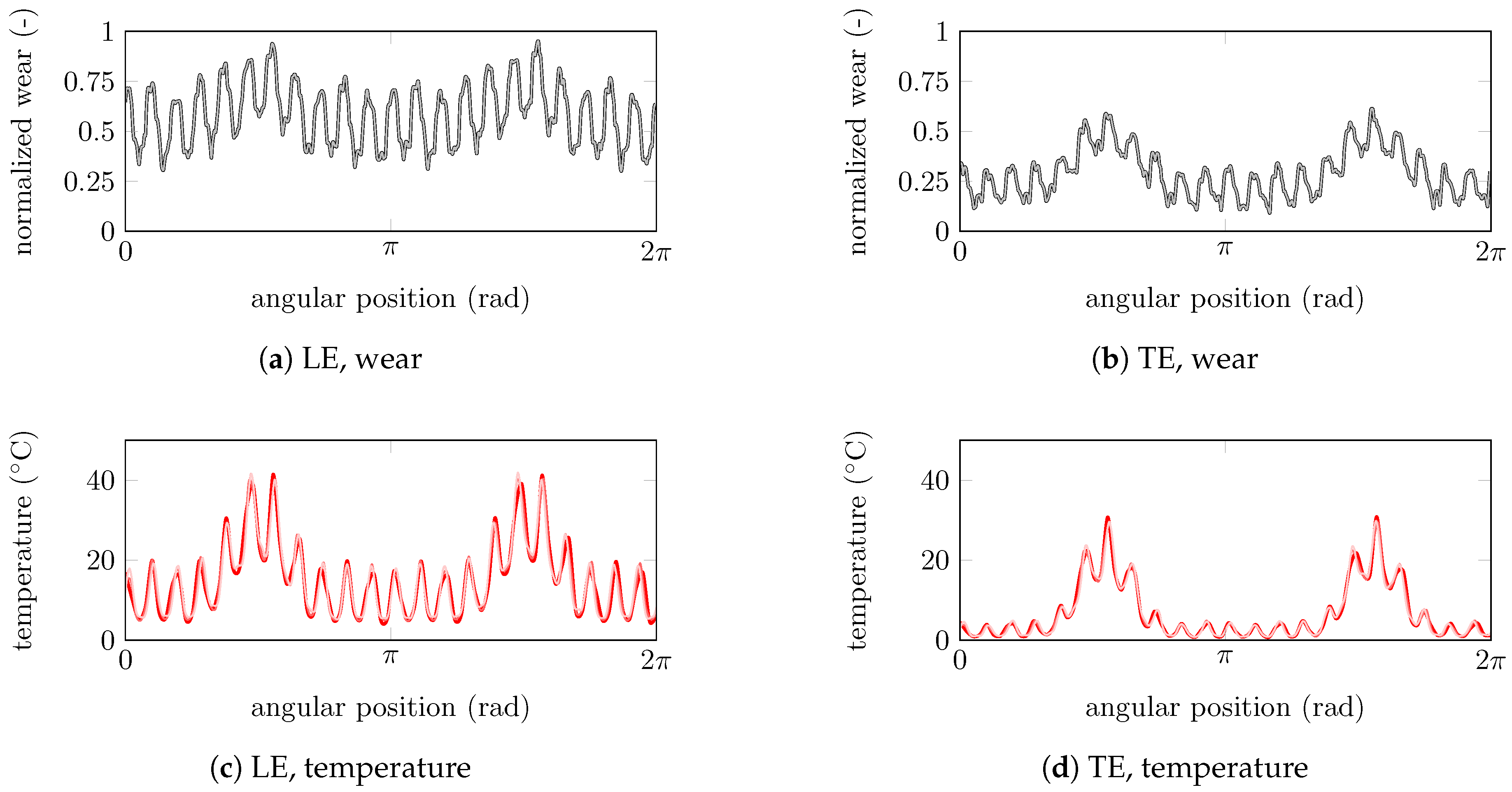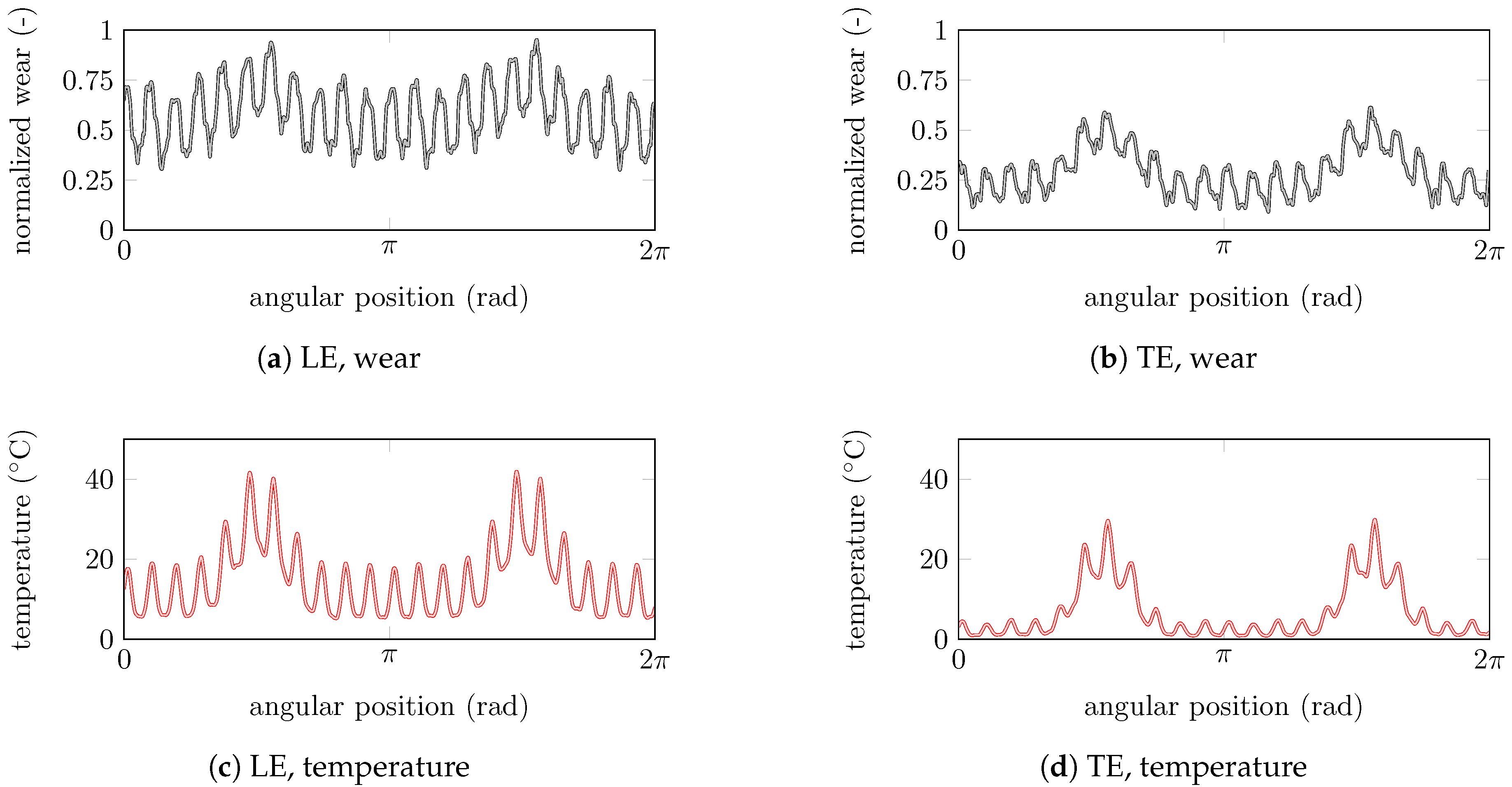Sensitivity Analysis of Rotor/Stator Interactions Accounting for Wear and Thermal Effects within Low- and High-Pressure Compressor Stages
Abstract
:1. Introduction
2. Numerical Model
2.1. Blade
2.2. Casing
2.3. Abradable Coating
2.3.1. Mechanical Mesh
2.3.2. Thermal Mesh
2.3.3. Thermo-Mechanical Coupling
2.4. Summary
3. Convergence Analysis
4. Experiments
4.1. Calibration of the Thermal Model
4.2. Application of the Calibrated Model
4.3. Partial Conclusion
5. Sensitivity Analysis
5.1. High-Pressure Compressor Blade
5.1.1. Influence of the Angular Speed
5.1.2. Influence of the Initial Clearance
5.1.3. Cross Analysis
 ) at higher angular speed for low initial gap values, 17 wear lobes (
) at higher angular speed for low initial gap values, 17 wear lobes (  ) at low initial gap values, and 22 wear lobes (
) at low initial gap values, and 22 wear lobes (  ) for intermediate gap values.
) for intermediate gap values.5.2. Low-Pressure Compressor Blade
5.2.1. Influence of the Angular Speed
5.2.2. Influence of the Initial Clearance
5.2.3. Cross Analysis
 ), and 15 wear lobes (
), and 15 wear lobes (  ). As for the HP compressor blade, the higher the angular speed, the lower initial clearance interactions occur. However, the two interaction areas are here well separated, with a more stable initiation of the interaction with the initial conditions. The 15 wear lobes is observed only at lower angular speed while the 7th engine order interaction responds for a large range of angular speeds and initial clearances. This cross analysis shows that depending on the engine nominal angular speed, a reduction of the nominal clearances in the engine design in order to improve the aerodynamic performance can lead to a risk of occurrence of interactions with other engine orders.
). As for the HP compressor blade, the higher the angular speed, the lower initial clearance interactions occur. However, the two interaction areas are here well separated, with a more stable initiation of the interaction with the initial conditions. The 15 wear lobes is observed only at lower angular speed while the 7th engine order interaction responds for a large range of angular speeds and initial clearances. This cross analysis shows that depending on the engine nominal angular speed, a reduction of the nominal clearances in the engine design in order to improve the aerodynamic performance can lead to a risk of occurrence of interactions with other engine orders.6. Conclusions
Author Contributions
Funding
Conflicts of Interest
References
- Williams, R.J. Simulation of blade casing interaction phenomena in gas turbines resulting from heavy tip rubs using an implicit time marching method. In Proceedings of the ASME Turbo Expo 2011 Conference, GT2011-45495, Vancouver, BC, Canada, 6–11 June 2011. [Google Scholar]
- Millecamps, A.; Brunel, J.; Dufrénoy, P.; Garcin, F.; Nucci, M. Influence of thermal effects during blade-casing contact experiments. In Proceedings of the ASME 2009 IDETC & CIE Conference, ASME, San Diego, CA, USA, 30 August–2 September 2009. [Google Scholar]
- Batailly, A.; Agrapart, Q.; Millecamps, A.; Brunel, J.F. Experimental and numerical simulation of a rotor/stator interaction event within an industrial high-pressure compressor. J. Sound Vib. 2016, 375, 308–331. [Google Scholar] [CrossRef] [Green Version]
- Muszynska, A.; Bently, D.; Franklin, W.; Hayashida, R.; Kingsley, L.; Curry, A. Influence of Rubbing on Rotor Dynamics—Part 1; Technical Report NAS8-36179; NASA: Washington, DC, USA, 1989. [Google Scholar]
- Borel, M.; Nicoll, A.; Schlapfer, H.; Schmid, R. The wear mechanisms occurring in abradable seals of gas turbines. Surf. Coat. Technol. 1989, 39, 117–126. [Google Scholar] [CrossRef] [Green Version]
- Mandard, R.; Witz, J.F.; Boidin, X.; Fabis, J.; Desplanques, Y.; Meriaux, J. Interacting force estimation during blade/seal rubs. Tribol. Int. 2015, 82, 504–513. [Google Scholar] [CrossRef] [Green Version]
- Salles, L.; Blanc, L.; Thouverez, F.; Gouskov, A. Dynamic analysis of fretting wear in friction contact interfaces. Int. J. Solids Struct. 2010, 48, 1513–1524. [Google Scholar] [CrossRef] [Green Version]
- Baïz, S. Etude expérimentale du contact aube/abradable: contribution à la caractérisation mécanique des matériaux abradables et de leur interaction dynamique sur banc rotatif avec une aube. Ph.D. Thesis, Ecole Centrale de Lille, Villeneuve-d’Ascq, France, 2011. [Google Scholar]
- Legrand, M.; Batailly, A.; Pierre, C. Numerical investigation of abradable coating removal through plastic constitutive law in aircraft engine. J. Comput. Nonlinear Dyn. 2011, 7, 011010. [Google Scholar] [CrossRef]
- Nyssen, F.; Batailly, A. Thermo-Mechanical Modeling of Abradable Coating Wear in Aircraft Engines. J. Eng. Gas Turbines Power 2019, 141, 021031. [Google Scholar] [CrossRef] [Green Version]
- Sternchüss, A.; Balmès, E. On the reduction of quasi-cyclic disks with variable rotation speeds. In Proceedings of the International Conference on Advanced Acoustics and Vibration Engineering (ISMA), Leuven, Belgium, 18–20 September 2006; pp. 3925–3939. [Google Scholar]
- Palfrey-Sneddon, H.; Neely, A.J.; Smith, E.O. The influence of descent and taxi profiles on the thermal state of a jet engine at shutdown. In Proceedings of the ISABE 2017 Conference, Manchester, UK, 3–8 September 2017. [Google Scholar]
- Adam, L. Modélisation du comportement thermo-élasto-viscoplastique des métaux soumis à grandes déformations. Application au formage superplastique. Ph.D. Thesis, Université de Liège, Liège, Belgium, 2003. [Google Scholar]
- Debard, Y. Méthode des éléments finis: thermique; Université du Mans: Le Mans, France, 2011. [Google Scholar]
- Jeong, C.Y. Effect of Alloying Elements on High TemperatureMechanical Properties for Piston Alloy. Mater. Trans. 2012, 53, 234–239. [Google Scholar] [CrossRef] [Green Version]
- Batailly, A.; Legrand, M.; Millecamps, A.; Garcin, F. Conjectural bifurcation analysis of the contact-induced vibratory response of an aircraft engine blade. J. Sound Vib. 2015, 348, 239–262. [Google Scholar] [CrossRef] [Green Version]
- Layachi, M.Y.; Bölcs, A. Effect of the axial spacing between rotor and stator with regard to the indexing in an axial compressor. In Proceedings of the ASME Turbo Expo 2001 Conference, GT2017-64342, New Orleans, LA, USA, 4–8 June 2001. [Google Scholar]
- Ameli, A. Numerical simulation of rotor/stator interaction and tip clearance flow in centrifugal compressors. Master’s Thesis, Lappeenranta University of Technology, Lappeenranta, Finland, 2015. [Google Scholar]
- Gourdain, N.; Wiassow, F.; Ottavy, X. Effect of Tip Clearance Dimensions and Control of Unsteady Flows in a Multi-Stage High-Pressure Compressor. J. Turbomach. 2012, 134, 051005. [Google Scholar] [CrossRef]
- Feng, J.; Luo, X.; Guo, P.; Wu, G. Influence of tip clearance on pressure fluctuations in an axial flow pump. J. Mech. Sci. Technol. 2016, 30, 1603–1610. [Google Scholar] [CrossRef]




 /
/  ), or (
), or (  /
/  ), or (
), or (  /
/  ), or (
), or (  /
/  ).
).
 /
/  ), or (
), or (  /
/  ), or (
), or (  /
/  ), or (
), or (  /
/  ).
).
 /
/  ), (
), (  /
/  ), (
), (  /
/  ), (
), (  /
/  ).
).
 /
/  ), (
), (  /
/  ), (
), (  /
/  ), (
), (  /
/  ).
).
 ), (
), (  ), (
), (  ), (
), (  ), and (b) : (
), and (b) : (  ), (
), (  ), (
), (  ), (
), (  ).
).
 ), (
), (  ), (
), (  ), (
), (  ), and (b) : (
), and (b) : (  ), (
), (  ), (
), (  ), (
), (  ).
).




 ), mid-chord (
), mid-chord (  ), and trailing edge (
), and trailing edge (  ) for the HP compressor test case.
) for the HP compressor test case.
 ), mid-chord (
), mid-chord (  ), and trailing edge (
), and trailing edge (  ) for the HP compressor test case.
) for the HP compressor test case.



 ), mid-chord (
), mid-chord (  ), and trailing edge (
), and trailing edge (  ) for the LP compressor test case.
) for the LP compressor test case.
 ), mid-chord (
), mid-chord (  ), and trailing edge (
), and trailing edge (  ) for the LP compressor test case.
) for the LP compressor test case.







 ): 5 wear lobes, (
): 5 wear lobes, (  ): 17 wear lobes, (
): 17 wear lobes, (  ): 22 wear lobes.
): 22 wear lobes.
 ): 5 wear lobes, (
): 5 wear lobes, (  ): 17 wear lobes, (
): 17 wear lobes, (  ): 22 wear lobes.
): 22 wear lobes.





 ): 7 wear lobes, (
): 7 wear lobes, (  ): 15 wear lobes.
): 15 wear lobes.
 ): 7 wear lobes, (
): 7 wear lobes, (  ): 15 wear lobes.
): 15 wear lobes.
© 2020 by the authors. Licensee MDPI, Basel, Switzerland. This article is an open access article distributed under the terms and conditions of the Creative Commons Attribution (CC BY) license (http://creativecommons.org/licenses/by/4.0/).
Share and Cite
Nyssen, F.; Batailly, A. Sensitivity Analysis of Rotor/Stator Interactions Accounting for Wear and Thermal Effects within Low- and High-Pressure Compressor Stages. Coatings 2020, 10, 74. https://doi.org/10.3390/coatings10010074
Nyssen F, Batailly A. Sensitivity Analysis of Rotor/Stator Interactions Accounting for Wear and Thermal Effects within Low- and High-Pressure Compressor Stages. Coatings. 2020; 10(1):74. https://doi.org/10.3390/coatings10010074
Chicago/Turabian StyleNyssen, Florence, and Alain Batailly. 2020. "Sensitivity Analysis of Rotor/Stator Interactions Accounting for Wear and Thermal Effects within Low- and High-Pressure Compressor Stages" Coatings 10, no. 1: 74. https://doi.org/10.3390/coatings10010074



